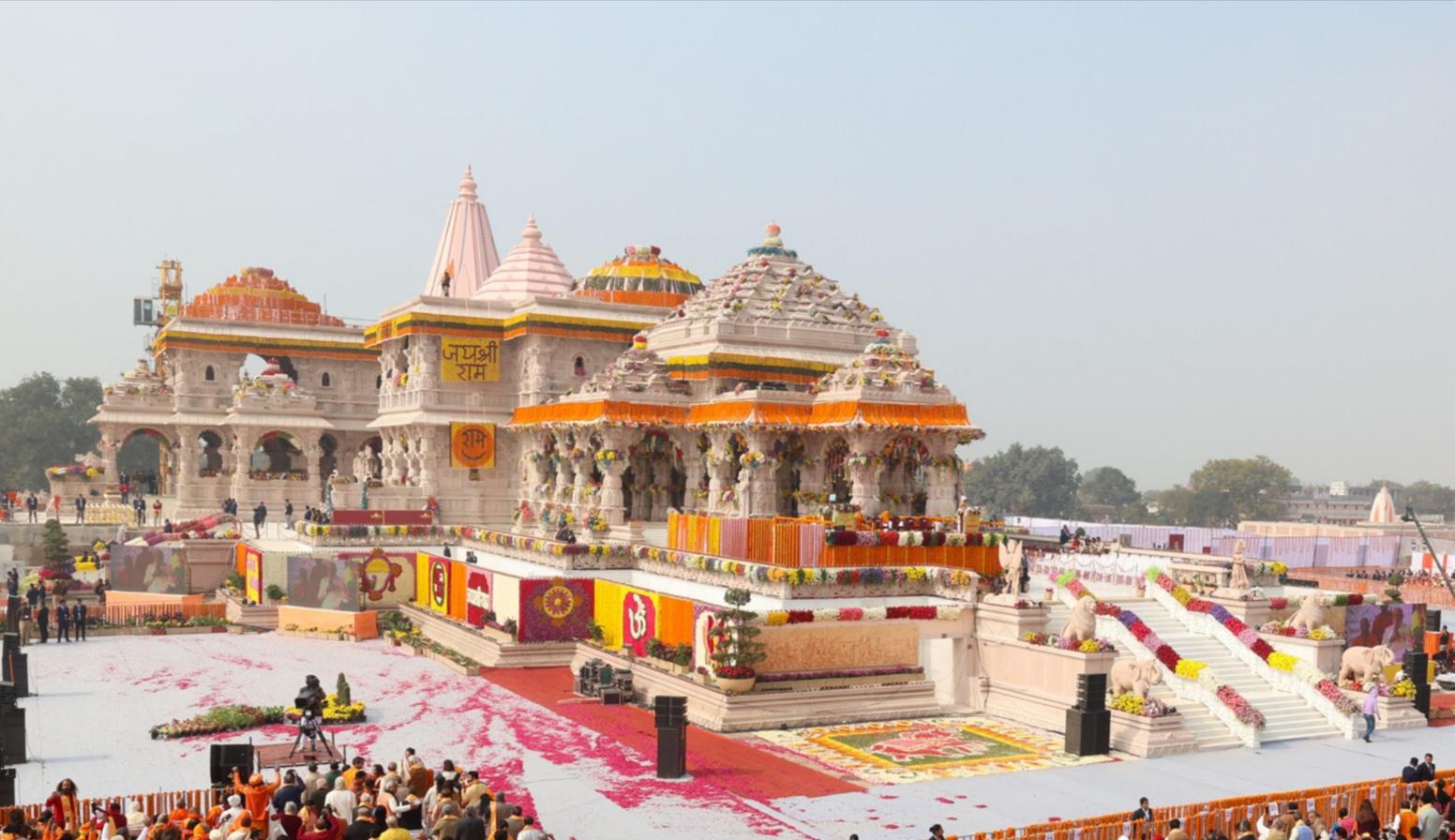History is once again being mauled on the pretext of resurrecting purportedly long-lost glory—to set India on a cleverly crafted course that is yet to find an electorally determined future for the polity, society, economy and so on. This is deserving of a deeper look that may cut through the morass of self-serving satisfaction and euphoria over the January 22 inauguration of the grand Ram temple in Ayodhya, against the backdrop of the looming parliamentary elections.
The cultural kick generated by the extravaganza has the potential to take public attention away from its several consequences that can have a detrimental effect on the lives and livelihoods of over a billion people.
Touted as course correction, the temple’s inauguration and its accompanying shenanigans have already been called out by the four Shankaracharyas. Yet, the so-called correction is said to be capable of unfolding a new era and a new wave of energy for the country to achieve as glorious a future as once was or could have been under the Ram Rajya of yore.
As for the steep decline from this glorious past, there are the foreign invaders and their misdeeds to blame for cultural ransacking.
Let us examine these fallacies. Amid what is sold these days as a relentless assault on Indian culture in medieval times, consider the fact that poets like Sur Das (15th century), Tulsidas (16th century), Kabir Das (14th century), Mirabai (16th century), Raskhan (16thcentury) and Rahim (16th century) flourished, besides many other artistes, with none of them ever complaining about censorship or any other misdemeanour on the part of the Muslim rulers or Mughal state of their times. Lord Ram and Krishna were not only lauded but also became deeply entrenched in the public mind in this era. None has been able to match these poets or their devotion till this day.
Contrast this with the case of Galileo Galilei (1564-1642) in Europe who had to struggle to save himself from going to the gallows as ordained by the state for his astronomical findings. No wonder the medieval period represents the Dark Age in Europe.
In India, these medieval-era poets were unstated laureates of their times. They were valued equally by the public and the state and are still read and recited with reverence in homes, seminaries, temples, gurudwaras and at the tombs of Muslim saints.
They shaped a kind of consciousness that was backed by strong morals and high ethical standards that cut across caste, creed, and faith and was shared by all, irrespective of status or social standing. Their compositions helped in building the self-esteem of the masses at a time when most people had little resources to learn about things that lay beyond the confines of their village as means of communication were limited in those days.
This morality achieved by Indians, courtesy of their poets and saints, a few centuries ago helped to reinvigorate national life and build the economy.
Land was measured through the better part of the country for the first time in the 16th century during Mughal rule. Communication was improved by building roads with saraisor inns along them for travellers with feed and water for their horses.
The Grand Trunk (GT) Road, originally known as Badshahi Sadak, was built during the reign of Sher Shah Suri and under the watch of his lieutenant, Raja Todar Mal (1500-89), who also worked under Emperor Akbar. The GT Road still runs from what is now Bangladesh to Peshawar in Pakistan, passing through both India and Pakistan except that the Trunk Road gets truncated at the borders of these countries. No other public thoroughfare can match this cross-country highway even today.
The Mughals are reputed for building monuments, but many gardens too were laid out during their rule. Kashmir’s Shalimar and Nishat gardens still survive to tell the story of a more imaginative past than is commonly acknowledged. That past is now being labelled as intolerant and bigoted, and charged with destroying temples at will to scare the masses and drive fear into their hearts.
Quite a few landmarks created during the Middle Ages were fine specimens of human ingenuity and enterprise that generally nursed art and architecture. Some of these have turned out to be places of great public utility and it shows that Mughal creations were not confined to forts and palaces.
The Babri Masjid was a specimen of Sharqi-Mughal architecture that deserved to be preserved rather than being subjected to the fate it met in December 1992.
These abiding works of art, architecture, or poetry would not have been possible in those times, had they been, as now alleged, plagued by strife, bigotry, and parochialism.
Circumstantial history was ignored in the Ayodhya dispute. From the State’s point of view, the Ayodhya dispute was more about the core, or basic tenets, of the law of the land rather than of Islam or Hinduism or the followers of the two faiths. To draw justification for what happened to the Masjid from the reversal of the Supreme Court’s order in the Shah Bano alimony case (1985) by the Rajiv Gandhi government looks contrived as two wrongs do not make a right.
And as for the issue of the economy and its plunder, the facts are quite otherwise. Parliamentarian and author Shashi Tharoor took this up in a debate held in 2014 in London and won the contest by a majority vote cast by a distinguished gathering and panel that mostly included Britons.
Tharoor said, “At the beginning of the 18th century India’s share of the world economy was 23%, as large as all of Europe put together. By the time we won independence, it had dropped to less than four percent. The reason was simple: India was governed for the benefit of Britain. Britain’s rise for 200 years was financed by its depredations in India.”
He also remarked, “Britain’s Industrial Revolution was built on the de-industrialisation of India—the destruction of Indian textiles and their replacement by manufacturing in England, using Indian raw material and exporting the finished products back to India and the rest of the world.
“The handloom weavers of Bengal had produced and exported some of the world’s most desirable fabrics, especially cheap but fine muslins, some light as woven air. Britain’s response was to cut off the thumbs of Bengali weavers, break their looms and impose duties and tariffs on Indian cloth, while flooding India and the world with cheaper fabric from the new satanic steam mills of Britain.”
So, from having nearly a one-fourth share of the world’s economy towards the end of Mughal rule, India has descended into deep debt. In 2023, India’s share of the global GDP was a mere 7.51% and by 2028 it is projected to creep up to roughly 8%.
From being first in the world, a good 300 years ago, the country draws satisfaction now from being the fifth largest economy and aspires to jump to third position in years to come though without setting a firm deadline.
No less than 800 million people are dependent on rations provided by the state and millions of young adults wait for their turn to get jobs. What else can speak better about India being a low-income country for most of its citizens without likelihood of a significant change in their lot in the near future?
As against this a tiny section of the Indian business class has come to thrive in recent years as never before. And it is this section that has placed its bet on the profound changes that the economy and polity have of late been undergoing amid a deepening sectarian divide and falling development indicators that relegate India in terms of hunger, health, and education vis-à-vis most other countries of the world. The wont of the privileged class is to discount alarm over this as everybody knows that the country’s minorities or mostly Muslims, who have a little over 14% share of population, are rapidly falling behind others and, thus, also taking down indicators bit by bit.
It is against this backdrop that the Ram Mandir has been inaugurated as a token of virtual endorsement of the current selective rather than a universal approach to both politics and economy. The huge number of Indians who continue to reel from the effects of low income is a result of this approach and it has its roots in caste, rather than in the alleged misdeeds of Muslim rulers who existed in a past too distant to have any effect currently. Yet, the contemporary is equated with medieval to blur issues and confuse people grappling with day-to-day concerns.
In his 1936 essay on annihilation of caste, Dr B.R. Ambedkar pointed this out more unreservedly than other thinkers who have reflected on caste. Ambedkar says, “That, without penal sanction the ideal of Chaturvarnya cannot be realized, is proved by the story in the Ramayana of Rama killing Shambuka (a Dalit who tried to take to meditation and learning or tapasya). Some people seem to blame Rama because he wantonly and without reason killed Shambuka. But to blame Rama for killing Shambuka is to misunderstand the whole situation. Ram Raj was a Raj based on Chaturvarnya.”
So India can unleash its full energy, capabilities and potential only by doing away with the varna system and ushering the millions into a new era through affirmative action to compensate for the loss suffered in the past.
Last, but not least, is the fact that Ayodhya was for long a legal issue until in November 2019 the Supreme Court pronounced the award of two plots for building both a temple and a mosque. But the temple has been inaugurated, unlike the mosque for which not even a brick has been laid to construct a replacement for the fallen shrine. This indicates not just a travesty of justice but its impossibility.


























